This Indian vegetable curry features end-of-summer vegetables bathed in a fragrant coconut-tamarind curry sauce. Perfect for using up your garden veggies! Vegan & gluten-free. Video.
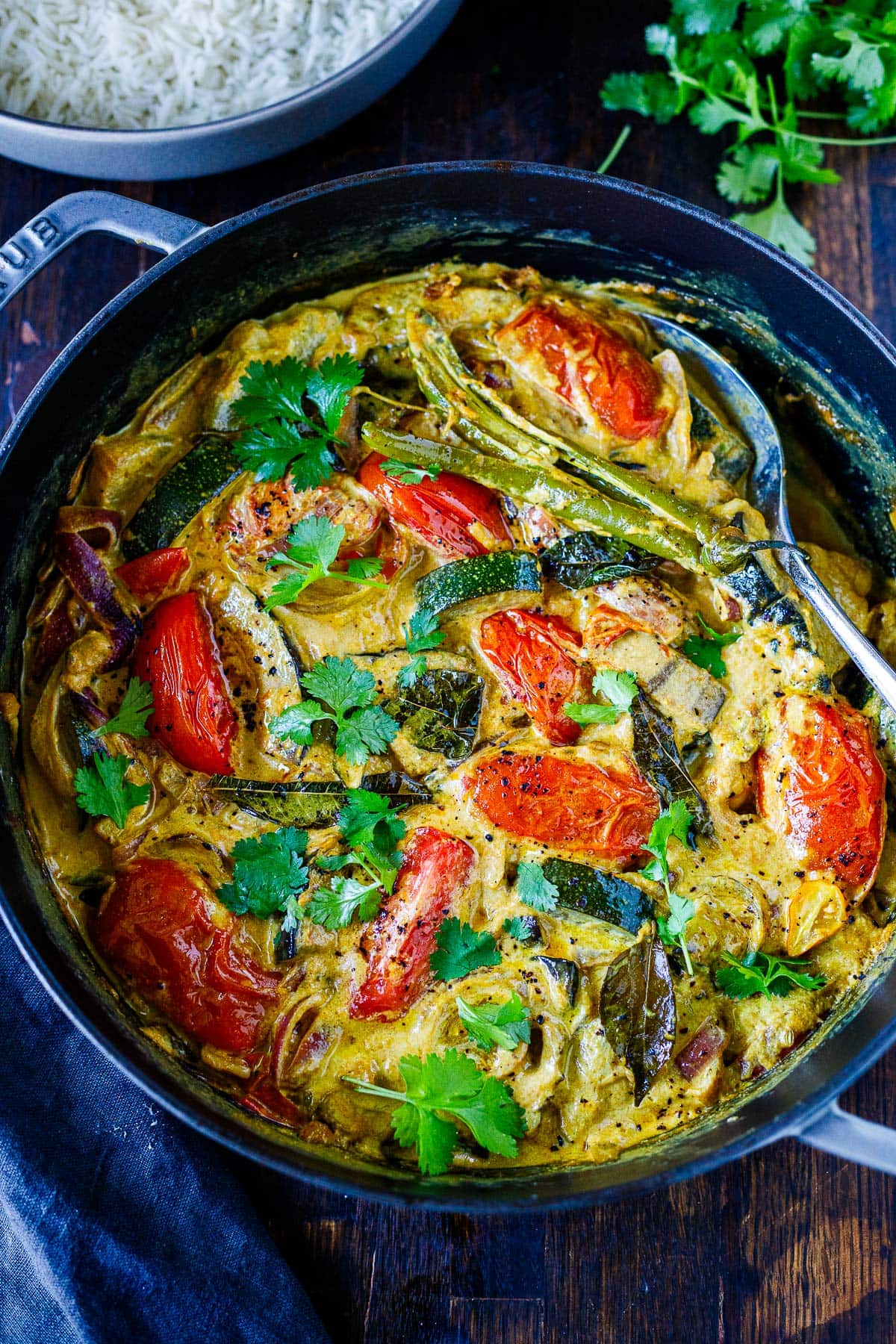
Why You’ll Love This Indian Curry Recipe
Every day, there are more zucchini in my garden; they seem to grow overnight! Here is one of my favorite vegetable curry recipes that hails from Kerala, in Southern India. Kerala is known for its tropical, hot climate, and is often referred to as the “land of spices.” This recipe is intentionally designed for warmer weather with veggies that grow in abundance at the end of summer.
It’s light, creamy, and wonderfully tangy, thanks to the addition of tamarind, and the toasted whole spices and curry leaves add another layer of flavor. It pairs perfectly with garden veggies like tomatoes, zucchini, peppers, corn or eggplant. Serve it over basmati rice or with naan for a simple, delicious vegan dinner.
Indian Curry Ingredients
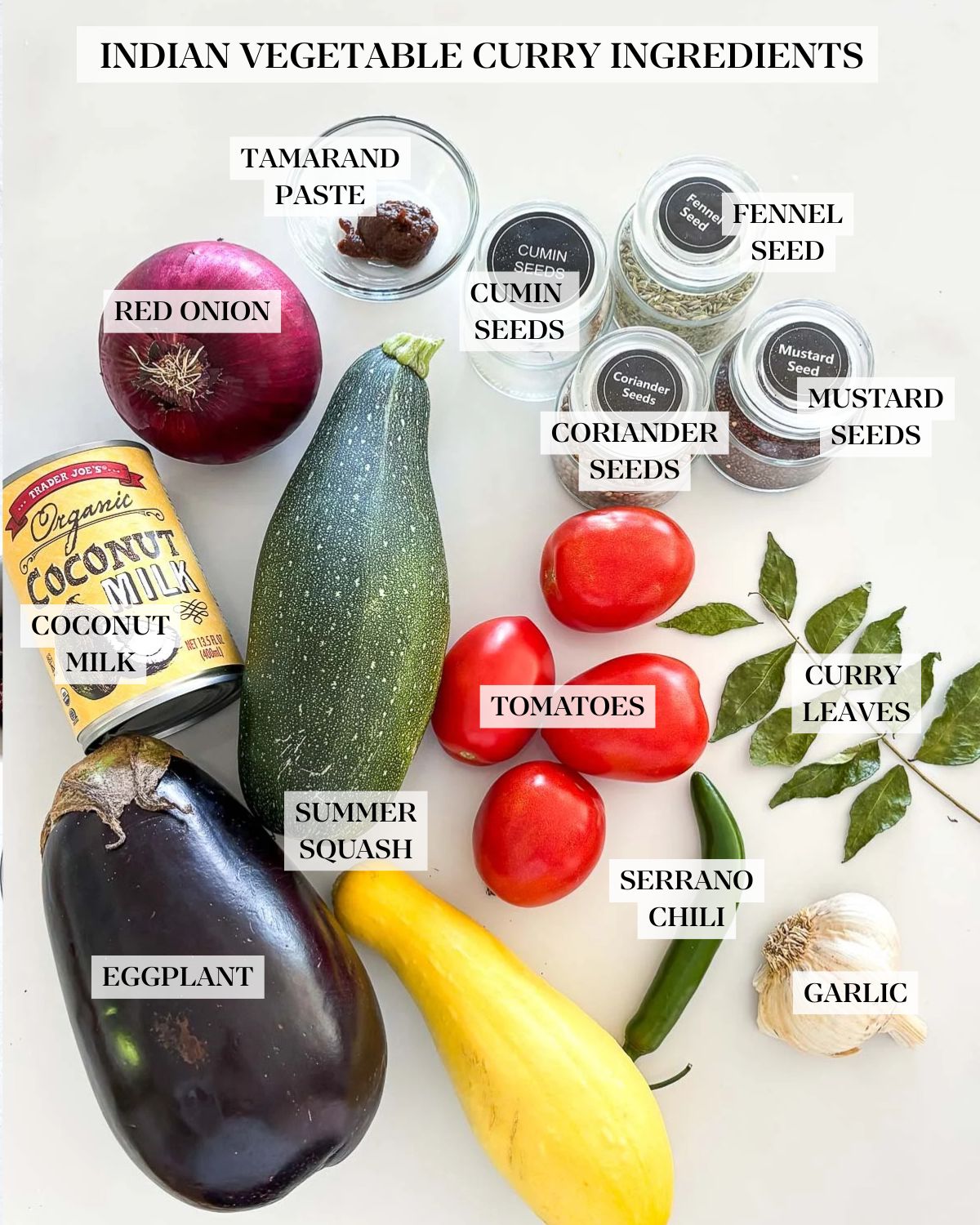
- Veggies: Zucchini, bell pepper, eggplant, corn, cauliflower florets, or mushrooms. Cut them roughly the same size for even cooking, or roast them separately, then add them to the curry.
- Red onion and garlic cloves: For savory, aromatic depth.
- Seeds: Fennel seeds, cumin seeds, black mustard seeds, and coriander seeds impart layers of unique flavor, spice, and complexity.
- Curry leaves: You can use fresh or frozen curry leaves.
- Full-fat coconut milk: Adds rich flavor and creamy texture.
- Tamarind paste: Adds a tangy flavor, perfect for summer!
- Cayenne pepper and turmeric powder: For subtle heat and warm, earthy flavor. More turmeric can be added to deepen the color of the curry.
- Serrano chilies: Split the chilies in half, leaving the stems intact.
- Roma tomatoes: Roma tomatoes are perfect for curry because they are firm and less juicy, staying intact.
- Cilantro: For a fresh, herby garnish.
Vegetable Curry Variations
Any of these can be added at the end of cooking for extra protein or heartiness. Remember to adjust the salt if making any of these additions.
- Crispy tofu (prepared with curry powder or garam masala)
- Chickpeas– season and add as is, or roast them first!
- Crispy paneer – sear cubes in ghee or coconut oil, then add at the end.
- Chicken- cube, season, and brown in a pan, then add at the end.
How to Make Indian Curry
1. Toast and grind the spices. Bring a large, 12-inch skillet, braiser, or large pot to medium-low heat. Toast the whole spices until toasty and fragrant. If they start popping, they are done. Grind them in a spice grinder or use a mortar and pestle to crush them. Remove from the pan and set aside.
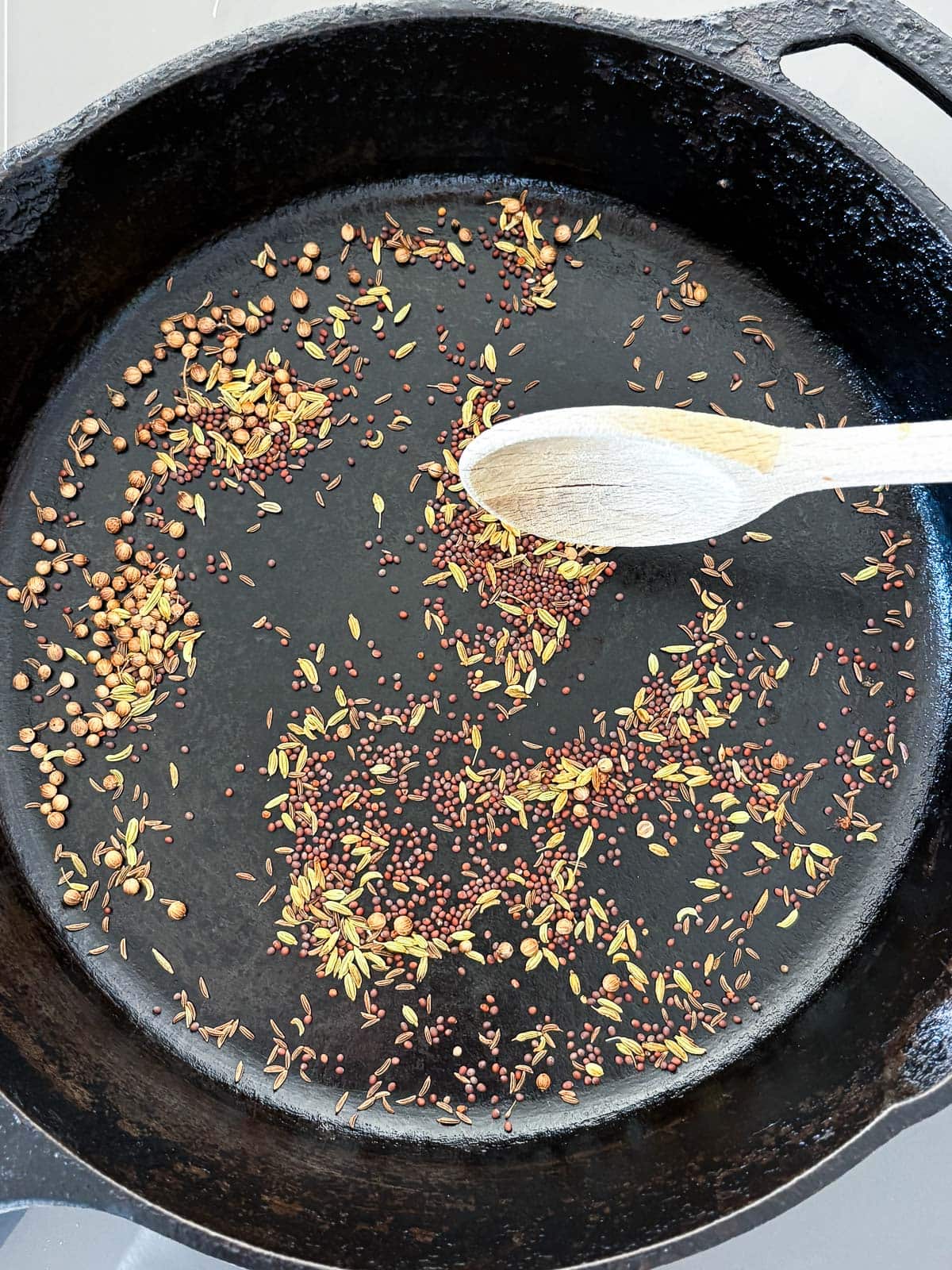

2. Sauté aromatics and vegetables. To the same pan, add olive oil (or avocado oil or coconut oil) and turn to medium-high heat. Add onion and sauté for 3-4 minutes, stirring until just tender and fragrant. Add garlic and reduce to medium heat. Cook 2 minutes. Add veggies and ground spices and cook for 2-3 mins more.

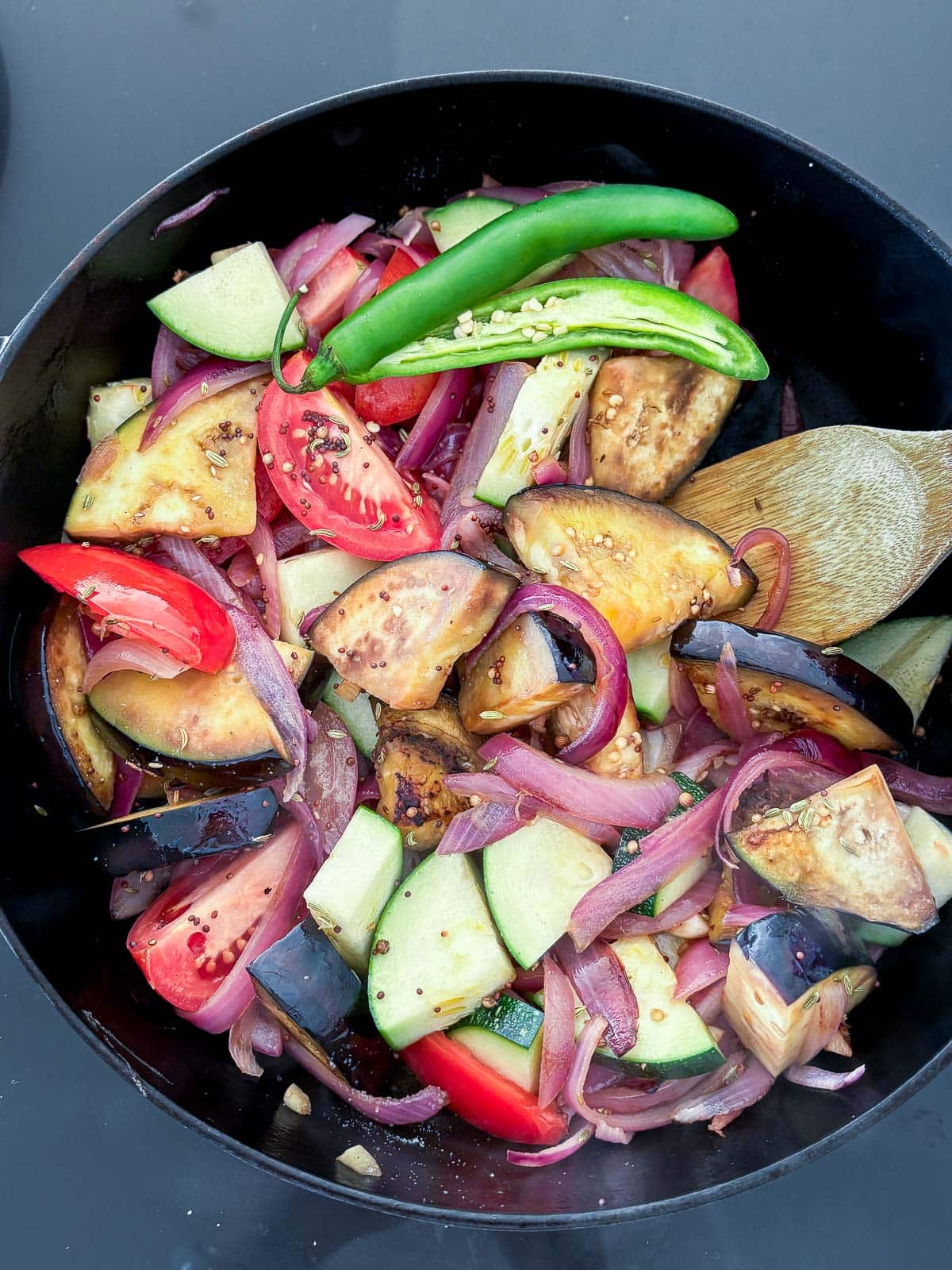
3. Add remaining curry ingredients. Stir in 10 curry leaves, coconut milk, 2 teaspoons tamarind paste, salt, cayenne and turmeric. Mix well. Nestle in tomatoes and chilies.
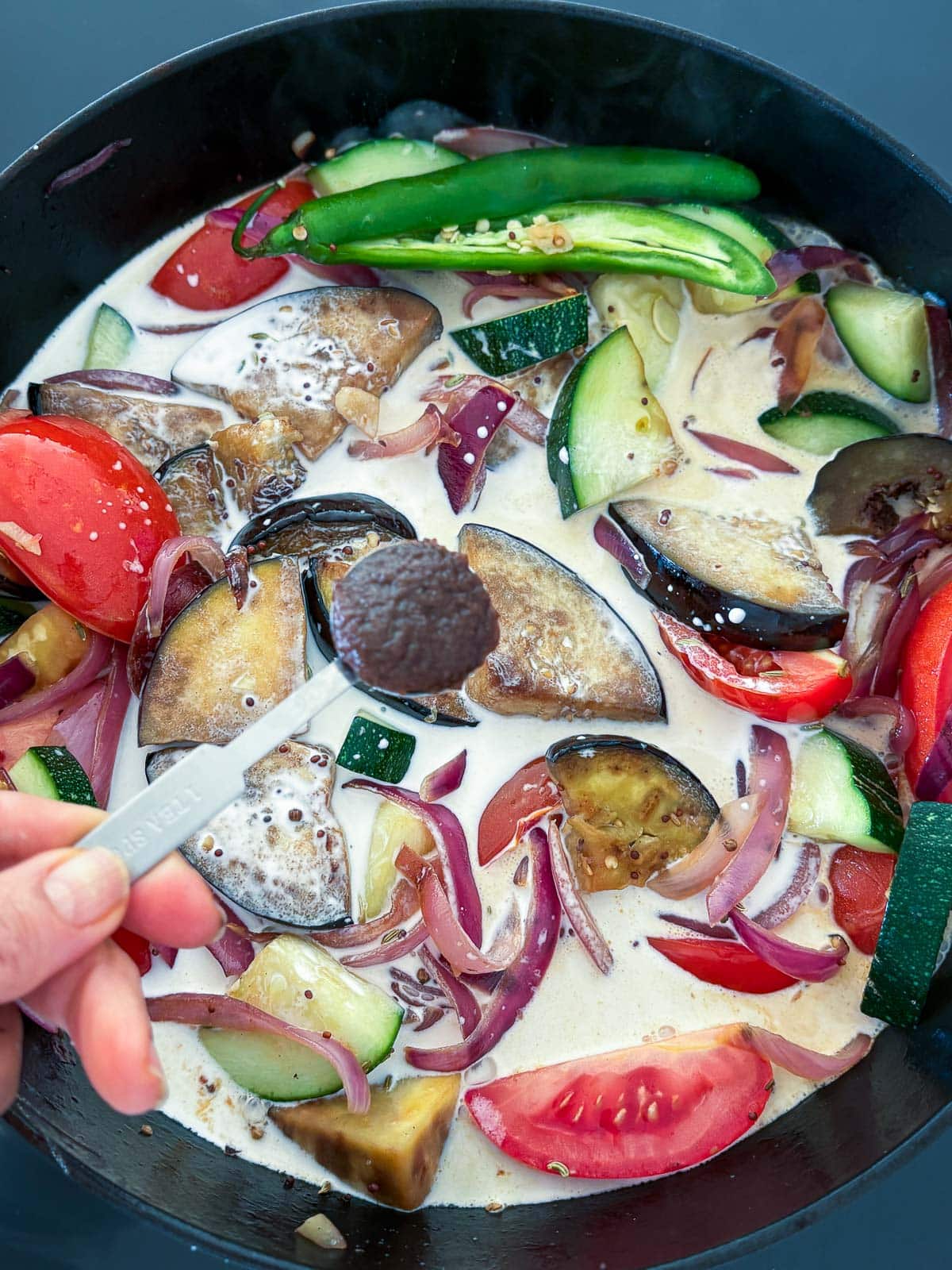
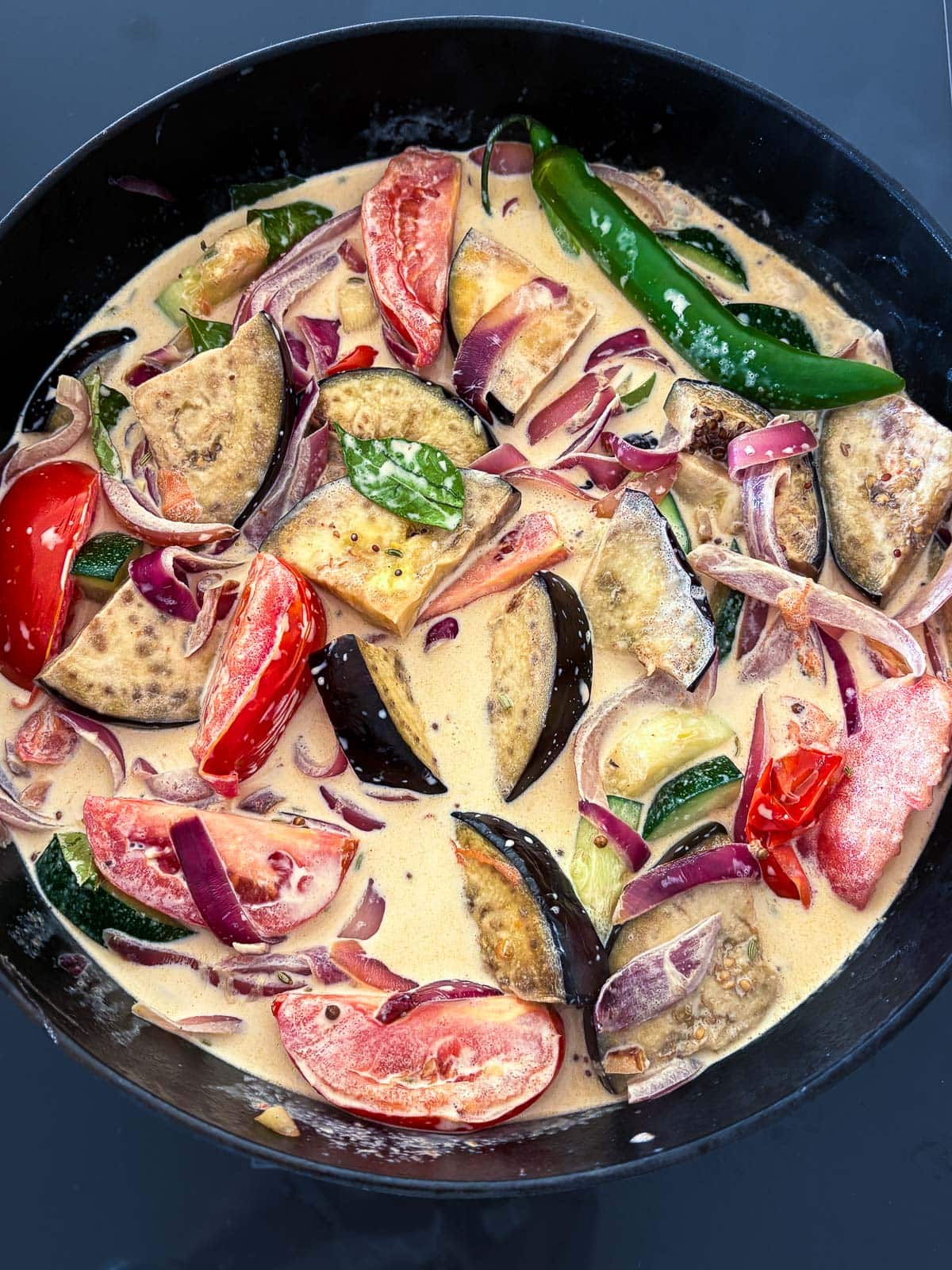
4. Simmer. Bring the pan to a simmer, then cover and simmer over medium-low heat for 10 minutes. Uncover, stir the pan once, then simmer uncovered without stirring for 15-20 minutes, or until veggies are tender and the coconut milk has reduced by at least a third. Excessive stirring will cause the tomatoes to fall apart, which we want to avoid. You can gently push the veggies underneath or spoon sauce over them to cook more evenly.
5. Taste and adjust. When the veggies are tender, turn off the heat. Taste and add salt or spice as needed. The tamarind and tomatoes provide acidity, but you can add a squeeze of lime or lemon for extra tang.
6. Garnish and serve. Garnish with fresh cilantro and serve over basmati rice or with naan. Or both!
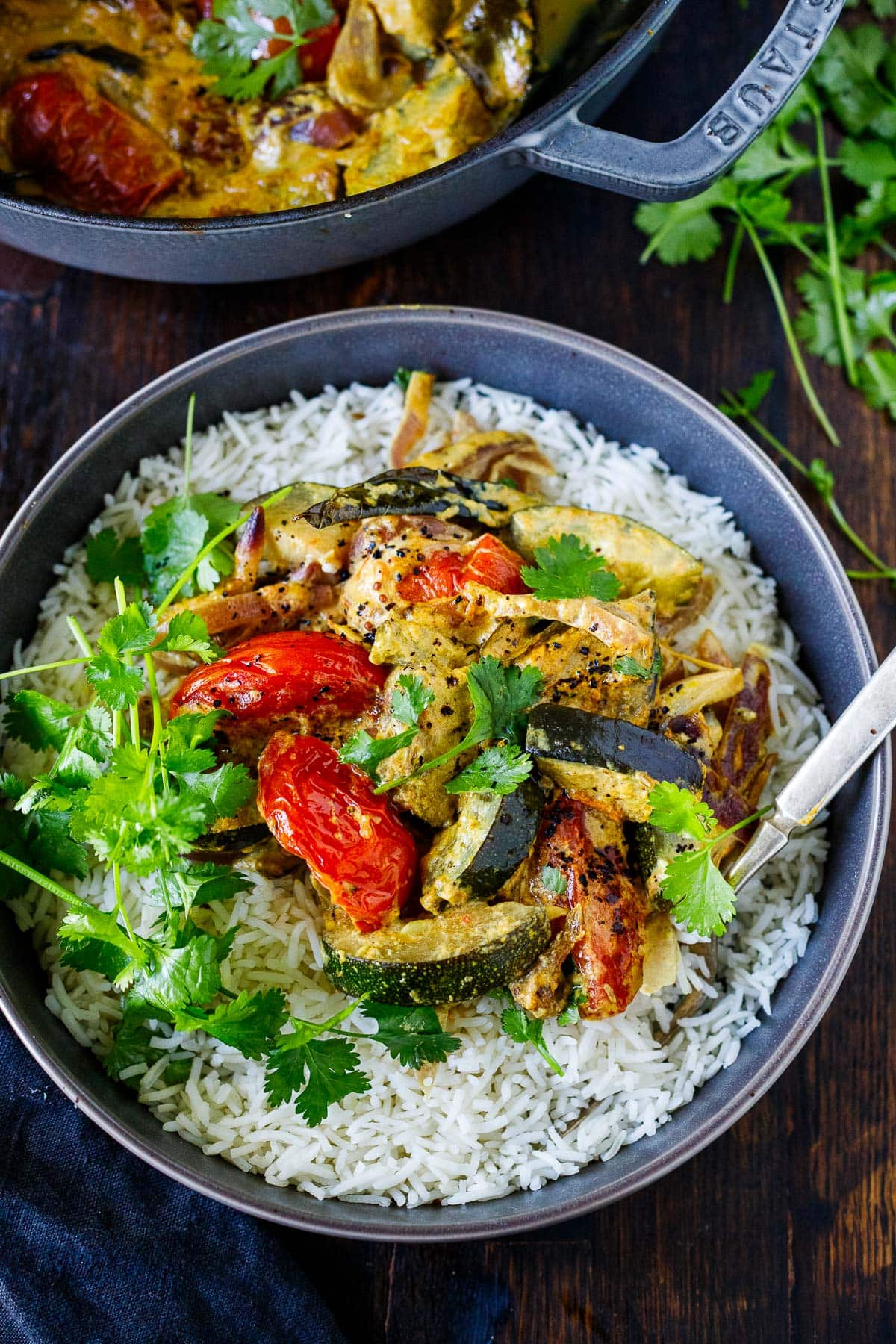
Chef’s Tips
- Cut the veggies with thought, for even cooking. If using eggplant, cut it into 1/4-inch thick slices (then cut into quarters). Zucchini can be sliced ½-inch thick, and bell peppers are perfect at 1-inch cubes. I haven’t tested the cauliflower, but I would make them small-ish. The goal is to have them cook in the same amount of time.
- Try roasting the veggies! You can roast the veggies separately and add them to the reduced sauce. Especially if adding longer cooking veggies like carrots or cauliflower.
- Use whole spices. Whole spices, when freshly ground, result in the best flavor. It’s great to keep your pantry stocked with a variety of whole spices to really elevate your cooking!
- Be careful not to stir too much. Stirring will cause the tomatoes to break down, and we want to keep them intact. When removing the lid, give the pan a gentle shake or stir, then let it simmer without stirring. If needed, you can gently push the veggies underneath or spoon some sauce over the top of the veggies.
Storing Vegetable Curry
- Refrigerator: To store leftovers, let the curry cool completely, then store it in an airtight container in the fridge for 3-4 days.
- Freezer: Curry can also be stored in the freezer for up to 3 months. Thaw overnight in the fridge before reheating.
- Reheating: Reheat on the stove over medium heat until warmed through, or in the microwave.
Serving Suggestions
Serve the vegetable curry with naan bread, roti, or paratha, and basmati rice. Here are some of our other favorite Indian cuisine dishes that could be paired with this curry!
Indian Curry FAQs
Any summer vegetables that can be cut into bite-sized pieces and achieve a tender, succulent texture, such as zucchini, bell pepper, eggplant, cauliflower florets, mushrooms, broccoli, green beans-really anything goes! Corn and green peas make a nice addition, too.
As soon as the vegetables are tender, turn off the heat, then taste and adjust for salt, spice, and acid (fresh lime juice can be added). Once the desired flavor profile is achieved, it is ready to serve warm.
Simmer the veg curry covered for 10 minutes, then uncovered for 15-20 minutes.
South Indian curry recipes are lighter, rice-based, and tangy with a tamarind and coconut base. North Indian curries are richer and creamier, often made with dairy and served with bread.
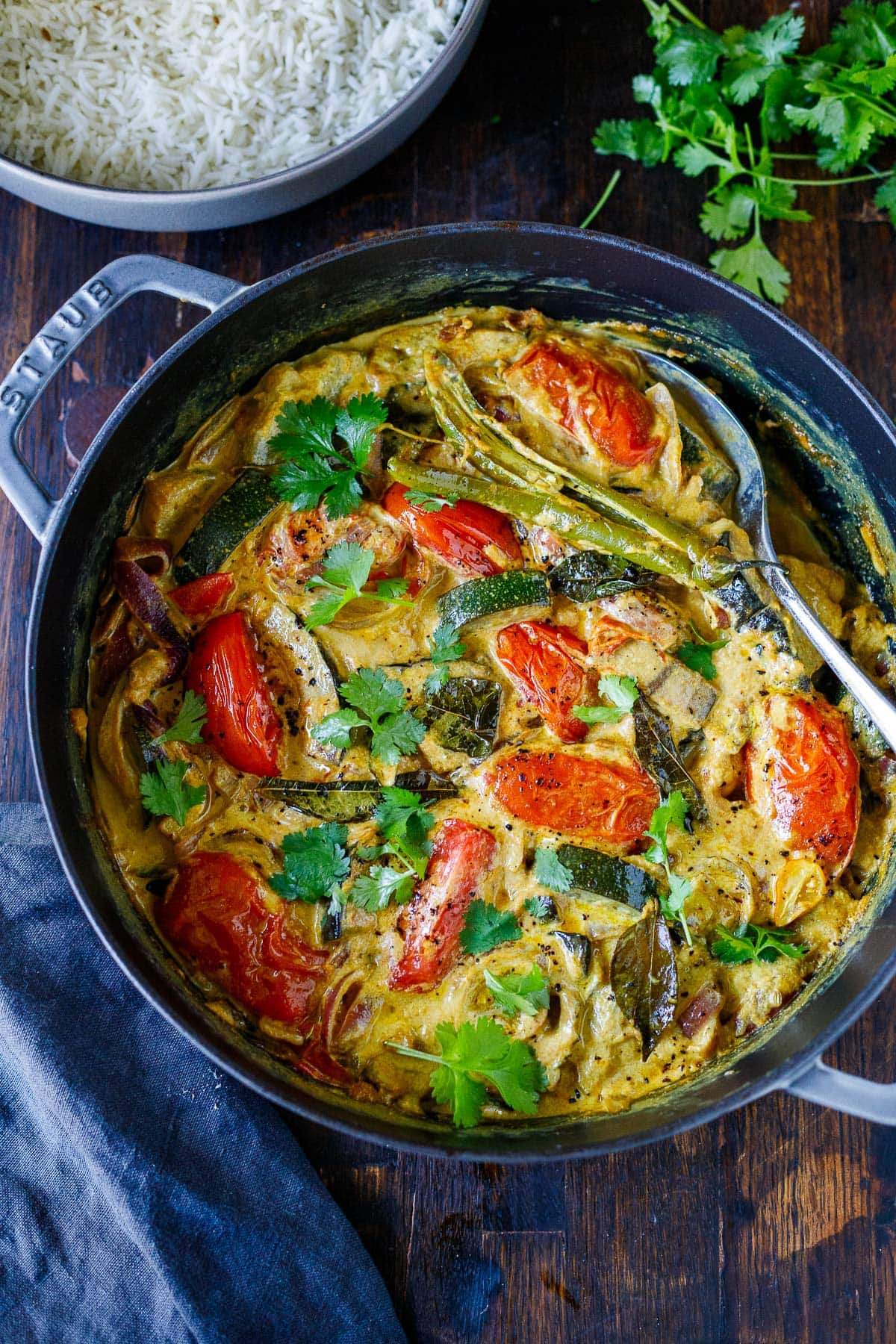
Hope you enjoy this late summer vegetable curry recipe. 🙂 When fall weather arrives, be sure to try our butternut squash curry, which can also be made with pumpkin or sweet potato! You’ll also love our Sweet Potato Soup made with yellow curry and turmeric, and our Vegetable Khichdi recipe.
Let us know what you think with a rating and comment!
More Curry Recipes You Might Like
Watch How to Make It
⭐️ After you try this Indian curry recipe, let us know how it turns out in the comments below. Your review will help other readers, too! Sign up here to join our community and receive our latest recipes and weekly newsletter! xoxo Sylvia

Indian Vegetable Curry Recipe
- Prep Time: 15
- Cook Time: 30
- Total Time: 45 minutes
- Yield: 4-6 1x
- Category: healthy dinner, vegan dinner, indian dinner recipe, gluten free recipe
- Method: stovetop
- Cuisine: Indian
- Diet: Vegan
Description
This Indian vegetable curry features end-of-summer vegetables in a fragrant, spice-infused coconut-tamarind curry sauce. Perfect for using up your garden veggies! Adapted from a recipe by Meera Sodha
Ingredients
- 1 1/2 teaspoons fennel seeds
- 1 1/2 teaspoons cumin seeds
- 1 1/2 teaspoons black mustard seeds
- 1 1/2 teaspoons coriander seeds
- 2 tablespoons olive oil
- one red onion, sliced
- 4 garlic cloves, roughly chopped
- 4 cups veggies: zucchini, bell pepper, eggplant, corn, cauliflower florets, or mushrooms (see notes)
- 10 curry leaves (fresh or frozen)
- 14–ounce coconut milk (full-fat)
- 2 teaspoons tamarind paste
- 1 1/2 teaspoons salt
- 1/4–1/2 teaspoon cayenne pepper
- 1/4–1/2 teaspoon turmeric powder, more for color
- 1–2 serrano chilies -split in half with the stem intact.
- 4 Roma tomatoes, quartered
- cilantro for garnish
Serve with naan or basmati rice.
Instructions
- In a large skillet or braiser, toast the spices over medium-low heat until toasty and fragrant. If they start popping, they are done. Grind or crush with a mortar and pestle and set aside.
- In the same pan, heat the olive oil over medium-high heat. Add the onion and saute, stirring, 3-4 minutes until just tender and fragrant. Add the garlic and lower the heat to medium, cook for two minutes. Add the vegetables and ground spices and cook for 2-3 minutes.
- Stir in the curry leaves, coconut milk, tamarind paste, salt, cayenne, and turmeric and mix well. Nestle in the tomatoes and chilies.
- Bring to a simmer, cover for 10 minutes, simmering over medium-low heat. Uncover, give one good stir, then simmer uncovered without stirring, for 15-20 more minutes or until veggies are tender and coconut milk has reduced by at least a third. Stirring will cause the tomatoes to fall apart, so try to avoid that. However, you can gently push the veggies underneath or spoon sauce over them to cook more evenly.
- Once the veggies are succulent and tender, turn the heat off. Adjust salt and spice level. The tamarind and tomatoes will add a good amount of acid, but if you want more, squeeze with lime.
- Sprinkle with fresh cilantro and serve over rice or with naan.
Notes
Veggies: If using eggplant, cut it smaller into 1/4 inch thick slices (then cut into quarters). Zucchini can be sliced ½ inch thick, and bell peppers are perfect at 1-inch cubes. I haven’t tested the cauliflower, but I would make them small-ish. You can always roast veggies separately and add them to the reduced sauce.
Variations: Feel free to add crispy tofu, chickpeas or crispy paneer (perhaps at the end) adjusting the salt.
Nutrition
- Serving Size: 1 cup
- Calories: 254
- Sugar: 8.4 g
- Sodium: 620.9 mg
- Fat: 20.3 g
- Saturated Fat: 13.3 g
- Carbohydrates: 18.3 g
- Fiber: 6.2 g
- Protein: 4.5 g
- Cholesterol: 0 mg
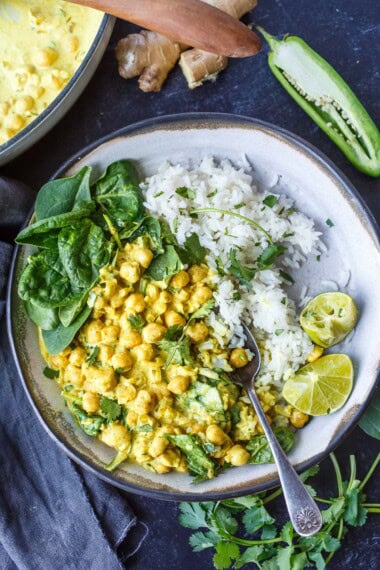
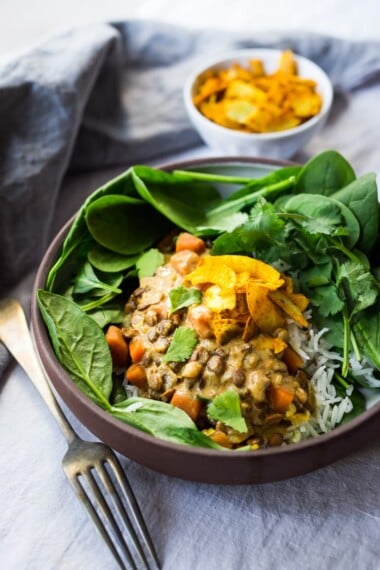
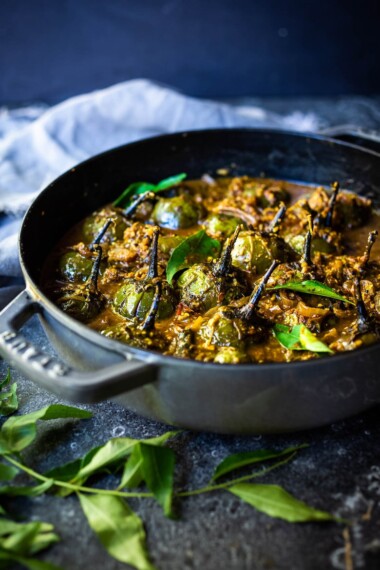
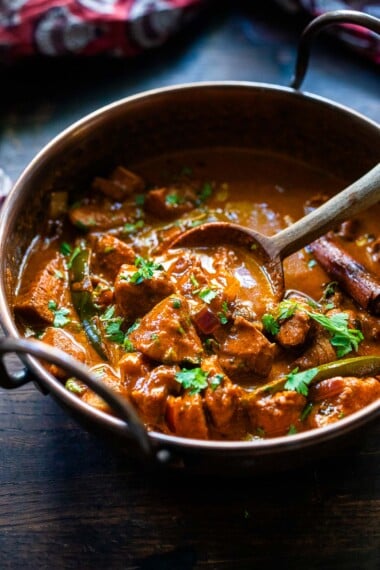


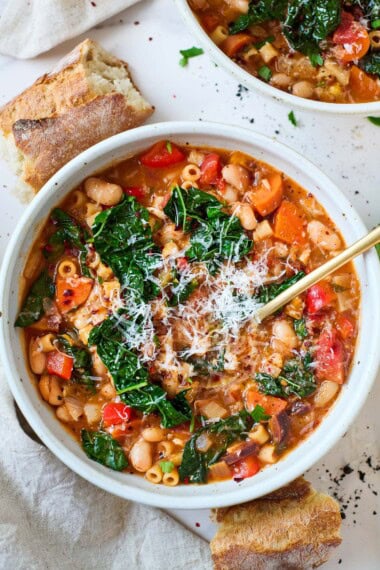


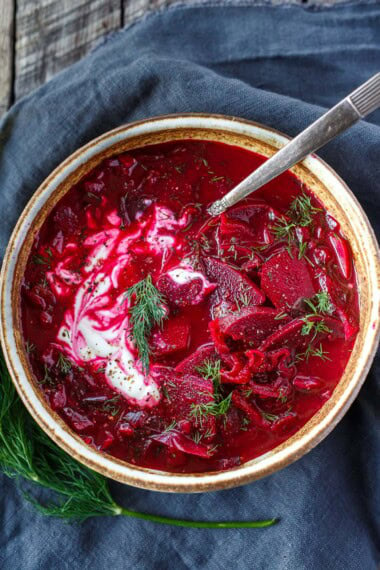



I guess it didn’t take the rating.
Thanks Dagmar. 🙂
I had commented on this recipe as well. Not sure what happened…I followed the recipe and used squash, sweet peppers, and broccoli. Served with lime sections. Sooo good! Thank you for another delicious recipe, Sylvia!
Made this vegetable curry with squash, peppers, and broccoli. The fresh curry leaves from my yard and the tamarind paste really elevate this dish beside the dry spices. This excellent recipe will be on repeat. Thank you!
Great to hear!
Perhaps I added more eggplant than the recipe called for but it only added did not subtract. Nice and warm & spicy — very very good.
Great to hear MK!
This was amazing!! I made it exactly as written using zucchini, peppers and tomatoes from the garden. My husband said this is the best dinner we have had in a long time. Looking forward to making it again soon. I felt it came together quickly and the flavors were perfect. Your recipes are reliable and Feasting at Home is my favorite cooking website. Thank you Sylvia!
So nice to hear this Jeanne, really appreciate you taking time to review!
PS I did just comment, but wanted to add that sometimes if I don’t have an ingredient or there’s something in the recipe. That’s not good for me or doesn’t agree with me, it’s so easy to just add alternatives and it always seems to work wonderfully. So thanks again for having this site and posting so many good recipes that are easy to find and follow through with.
Appreciate this Helene!
OMG this is AMAZING! We put a few handfuls of chickpeas in it for protein and a squeeze of lime for more acid, otherwise followed the recipe as written. Fancy dinner party worthy!
Awesome Teresa! Appreciate your review. 🙂
This didn’t turn out to good for me unfortunately…. But I’m still obsessed with your recipes and appreciate you so much! You are so detailed, easy to follow and health conscious. I tell everyone about you.
Thanks Ray- I appreciate your feedback! Can you give more specifics about what you didn’t like? Did you adjust the recipe at all?
I actually made it again and it turned out really good! The last time I tried it I don’t think the eggplant cooked through. This time my family really enjoyed it. Thank you for EVERYTHING you do for this community. You are so gifted!
Great- I’m so glad it worked better the second time. And thanks so much for you kind words!
This was really good and a nice change from my usual Indian curries. We don’t use coconut milk so I subbed cashew milk and a touch of maple syrup. Roasted eggplant, zucchini and sweet potatoes and also added some frozen green peas. I added the curry leaves with the garlic to pop their flavor. Used a touch more tamarind paste and used the lime juice as well. Balancing the flavors at the end is a must and well worth the extra effort! Thank you for another delightful recipe!
So glad this worked for you Patricia!
This curry was soooo good! When friends were coming for dinner, I decided this would be perfect. And it was. I left out the chilies since some are sensitive to heat in our group. One friend chopped all the veggies and I did the cooking. Sublime. Thanks for all the fabulous recipes!
So happy you enjoyed this on Kristin!
I’d love to make this….is there an alternative for tamarind paste?
It is a sweet tart balance so something like lemon juice, lime, or wine vinegar with a touch of sweetener- maple, brown sugar or honey.
What a great recipe! My husband and I both loved it! Such an interesting taste with the tamarind! And the colors in the dish are beautiful. I added crispy tofu for more protein. I used your method for crisping Sylvia and it was much crisper than other efforts I have made! Great explanations in your recipes. Thank you!
Wonderful Carol! Love the tofu addition. Appreciate your review!
This was really, really good and the perfect recipe for Fall garden produce. We happened to have all the ingredients on hand and served it along with basmati rice. As for serving 4-6 people, the 2 of us wolfed down about 2/3 of the recipe by ourselves – just enough leftovers for my husband for a hearty lunch. Thanks for another great recipe for our files. We will definitely be making this again.
So happy to hear this Mary! Thanks much for your review.
I’m going to do the roasted vegetable version of this on the weekend…as I live in tropical Far North Queensland, this type of meal is ideal, and I have curry leaves and fresh Turmeric (plus a whole lot of other spices like ginger, fresh tamarind, pandan, galangal and black pepper) growing in my garden.
Your garden sounds amazing Sandra! Let us know how it turns out.
So good! We’ve been eating it the last three nights.
So glad you are enjoying!
I love it❤
Awesome Victoria!
I love curry dishes. This sounds wonderful. I will be trying it.
Great Sonya! Love to hear what you think.
This sounds delicious! Thanks! Love curries and dals.
Hope you give it a try!